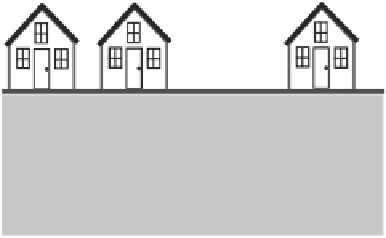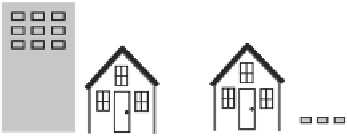Environmental Engineering Reference
In-Depth Information
40% evapotranspiration
38% evapotranspiration
10%
runoff
20%
runoff
21% shallow
infiltration
25% shallow
infiltration
21% deep
infiltration
25% deep
infiltration
Natural ground cover
10-20% Impervious surface
35% evapotranspiration
30% evapotranspiration
55%
runoff
30%
runoff
20% shallow
infiltration
10% shallow
infiltration
15% deep
infiltration
5% deep
infiltration
35-50% Impervious surface
55-100% Impervious surface
Figure 9.9
Effect of surface cover on stormwater runoff.
From Federal Interagency Stream Restoration Working Group (FISRWG), 1998.
fuel, pesticides, fertilizers, and salt used for snow melting) and litter (e.g., discarded cups,
plastic bags, and cigarette butts) that are then carried to surface water bodies. Particularly in
food-processing areas, stormwater can mobilize pollutants and pathogens from uncovered
waste containers, from spilled liquids or solids, and residues from material handling and
receiving sites.
The new approach to stormwater management is based on two principles: reduction of
runoff by promotion of natural water infiltration in the vicinity of the rainfall area, and because
100 percent infiltration is unattainable, delay of the residual runoff to avoid peak discharges.
Many methods are available to promote water infiltration in the ground. First, impervious
surfaces need to be minimized. This can be achieved by reducing the size of parking lots when
possible, or by using porous asphalt, porous concrete, modular block pavers, or other
specialized systems (DOE, 2001). In addition, the use of filter strips (i.e., narrow vegetated
areas) around impervious areas helps to capture and retain sediments and pollutants. Excess
water from filter strips can be redirected to a swale, which is a depression in the land forming
a channel that is covered normally with grass. Swales slow down the rate of runoffs, remove







































































































































































































































































































































































































































































































































































































































































































































































































































































































































































































































































































































































































































































































































































































































































































































































































































































































































































































































































































































































































